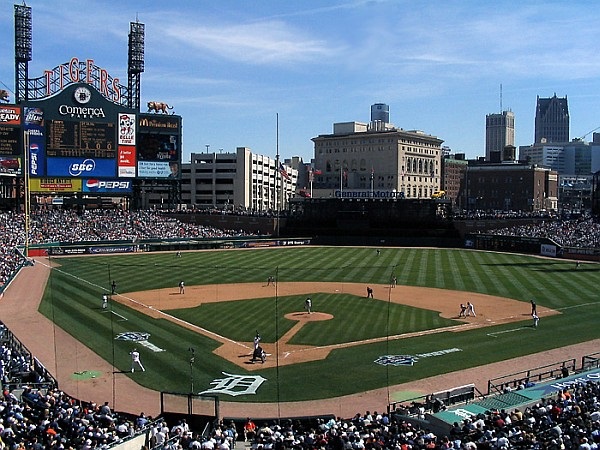
Image Credit: Dave Hogg (CC BY 2.0)
We've all heard the saying, "chicks dig the long ball". And that's a true statement. However, no matter your age or gender, there isn't a more exciting moment during a Major League Baseball game than seeing a home run launched into the outfield seats. Say what you will about Major League Baseball's "steroid era", during the 1990's and early 2000's but many of us kind of miss it. Nevertheless, there are a number of ballparks in Major League Baseball where fans can usually count on seeing at least one home run every single game. Here are the 7 Major League ballparks that give up the most home runs virtually every season.
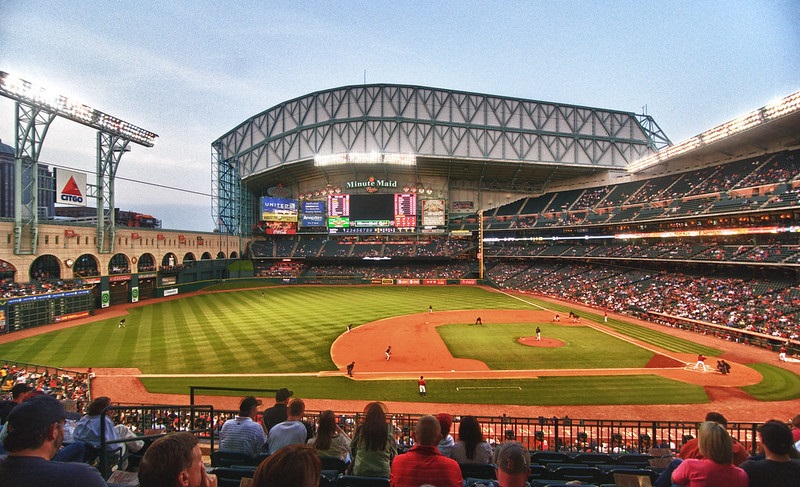
Image Credit: Eric Kilby (CC BY-SA 2.0)
7. Minute Maid Park. Home of the Houston Astros.
Minute Maid Park gave up 198 home runs during the 2015 MLB season, an average of 2.44 home runs per game. With it's extremely deep center field (435 feet from home plate) and high outfield walls in left field (Crawford Boxes), many baseball fans wouldn't anticipate Minute Maid Park being a home run friendly ballpark by looking at it's dimensions. But it is! In fact, the majority of Minute Maid Park's home runs are hit over the left field wall. Down the left field line, the wall is only 315 feet from home plate. Right field is 326 feet from home plate.
Minute Maid Park also offers perhaps the coolest home run feature in Major League Baseball. Whenever a home run is it by the Astros, a train sets in motion at the top of the stadium in left center field. The feature pays tribute to Houston's Union Station which formerly occupied the current site of Minute Maid Park.
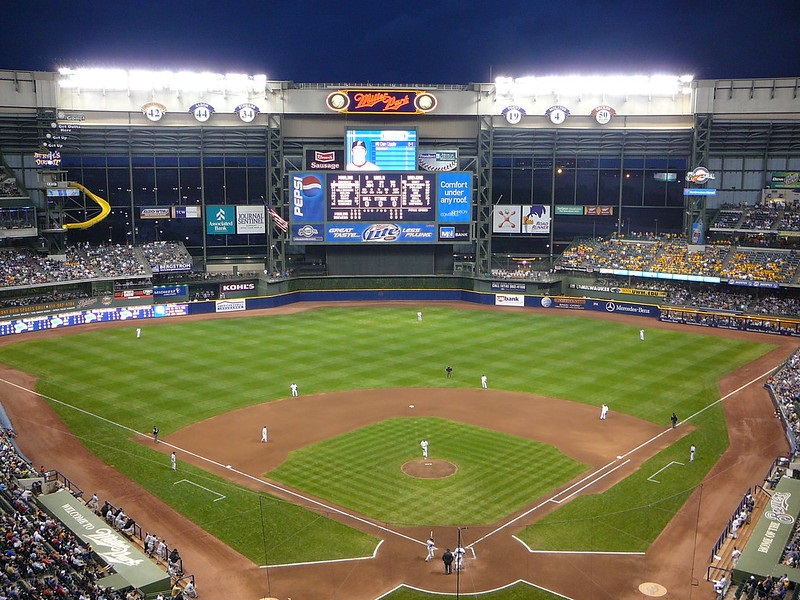
Image Credit: Jim Chou (CC BY 2.0)
6. Miller Park. Home of the Milwaukee Brewers.
Miller Park gave up 189 home runs in 2015 which averaged out to 2.33 home runs per game. The ballpark is perhaps the most symmetrical ballpark in Major League Baseball, with left and right field standing 345 feet from home plate and center field standing 400 feet from home plate. The landing spots for home runs in the outfield in 2015 were also very scattered with left field seeing slightly more home runs than right field. The outfield fence height varies from 6 to 12 feet. Like Minute Maid Park in Houston, having a retractable roof also benefits players because the outdoor conditions (wind, moisture) no longer become a factor.
One thing is for sure, watching home runs fly out at Miller Park was much funner when Ryan Braun and Prince Fielder were teammates.
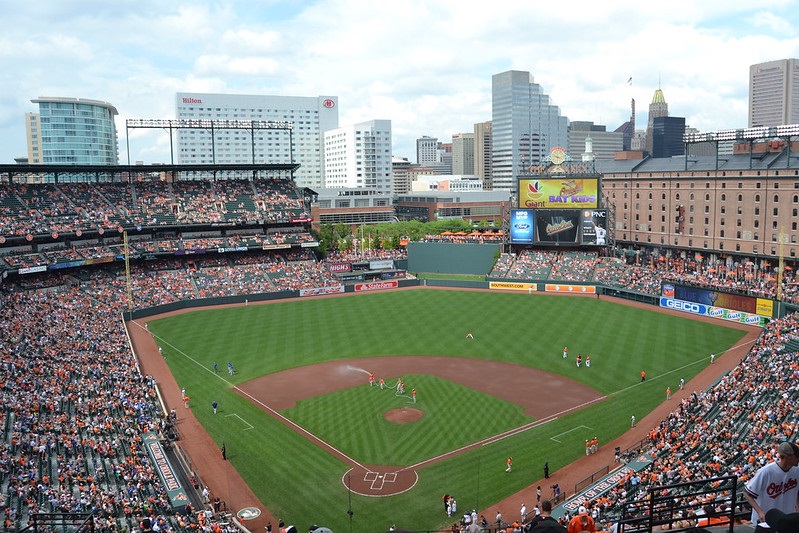
Image Credit: Ethan Gruber (CC BY-SA 2.0)
5. Oriole Park at Camden Yards. Home of the Baltimore Orioles.
Not only is Camden Yards considered to be the "It" ballpark, it's also a ballpark that gives up a ton of home runs. The ballpark led Major League Baseball in home runs in 2015, giving up a whopping 222 home runs and 2.85 home runs per game. The landing spots were also very spread out. Down the line in left field, the wall stands 333 feet from home plate. Down the line in right field, the wall stands 318 feet from home plate. Dead center field is 410 feet from home plate. The ballpark is best for left handed power hitters, even though the right field wall stands 25 feet tall. The left and center field walls, on the other hand, are only 7 feet tall.
If you ever visit Oriole Park at Camden Yards, be sure you check out Eutaw Street behind the ballpark. There you'll see baseballs designating the landing spots of home runs that landed on Eutaw Street. To my knowledge, Baltimore Oriole Chris Davis holds the record for the longest home run to land on Eutaw Street.
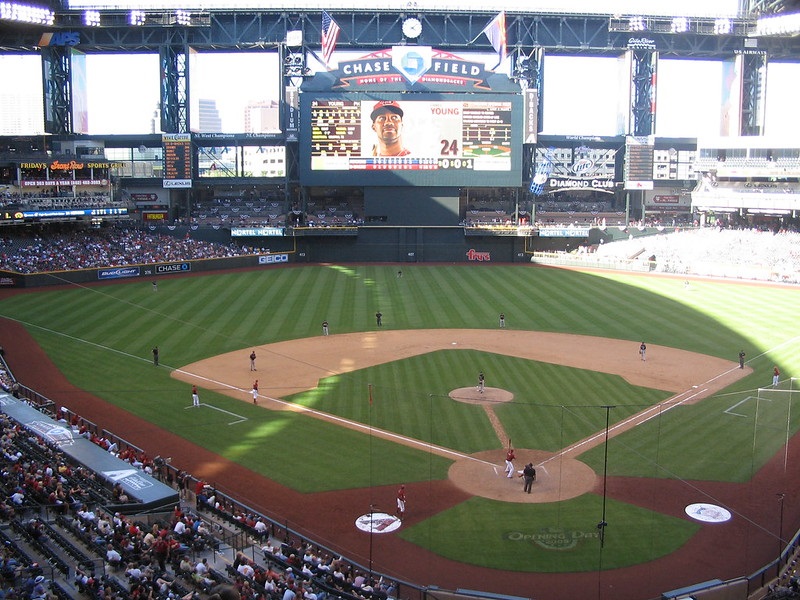
Image Credit: Nick Bastian (CC BY-ND 2.0)
4. Chase Field. Home of the Arizona Diamondbacks.
Chase Field only gave up 155 home runs in 2015 or 1.91 home runs per game but it has consistently been one of the most home run friendly ballparks since it opened in 1998. The city of Phoenix has a very high altitude and the desert heat makes the atmosphere very dry (18% humidity). In fact, the Arizona Diamondbacks organization considered storing their baseballs in a humidor system like the Colorado Rockies organization uses. The humidor would make the baseballs more moist and thus, harder to hit out of the ballpark.
Very few home run balls were hit to center field in 2015, which stands 407 feet from home plate with a 25 foot fence. Like Miller Park in Milwaukee, Chase Field is also a very symmetrical ballpark with the left and right field walls standing 330 feet from home plate. The ballpark also has a retractable roof which eliminates any outside weather factors although Phoenix's weather is often very predictable: dry and hot.

Image Credit: Redlegsfan21/Flickr (CC BY-SA 2.0)
3. Yankee Stadium. Home of the New York Yankees.
Yankee Stadium gives up a ton of home runs and it's not because the New York Yankees almost always have a high powered offense. Right field is very short at Yankee Stadium, standing 314 feet with an 8 foot wall. Like the old Yankee Stadium, new Yankee Stadium is a ballpark than benefits left handed hitters greatly. Yankee Stadium gave up 219 home runs in 2015 and 2.70 homes per game. The left field wall stands 318 feet from home plate and center field is 408 feet from home plate.
On that note, Yankee Stadium is also a terrible ballpark for extra base hits due to it's short outfields. Routine pop fly's at Petco Park, home of the San Diego Padres, would often be home runs at Yankee Stadium.

Image Credit: Redlegsfan21/Flickr (CC BY-SA 2.0)
2. Great American Ballpark. Home of the Cincinnati Reds.
Great American Ballpark consistently leads the National League in the amount of home runs it gives up. It gives up more home runs to right handed hitters than any other Major League ballpark. In 2015, Great American Ballpark gave up 183 home runs total and 2.26 home runs per game. Left field is 328 feet from home plate and right field is 325 feet from home plate. Center field also sees it's share of home runs, standing only 404 feet from home plate. The left field wall stands 12 feet high while the right field wall stands 8 feet high.
I'll never forget the longest home run in Cincinnati Reds history was when Adam Dunn hit a 535 foot home run that landed in the Ohio River. The Ohio River is considered a part of Kentucky. Dunn's home was the only home run to ever cross state lines in Major League Baseball history. Don't forget, Ken Griffey Jr. was also a teammate of Adam Dunn's during this time period. Great American Ballpark was a launching pad in the early and mid 2000's. Check out the home run.
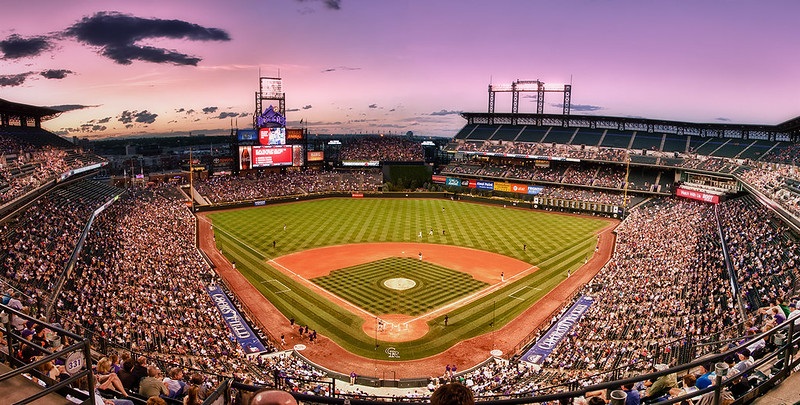
Image Credit: Max Bernt (CC BY 2.0)
1. Coors Field. Home of the Colorado Rockies.
Given Denver, Colorado's geography a mile above sea level, I don't know if Major League Baseball could build a ballpark that gives up more home runs than Coors Field. Coors Field gives up so much offense that the Colorado Rockies organization stores their baseballs in a humidor to make them drier and less likely to travel as far. The high altitude and dry air also effects the movement of pitches. With the largest fair territory in Major League Baseball, Coors Field is also a haven for extra base hits. Having a speedy outfield on defense is a must for the Colorado Rockies every single season. Right handed hitters have a slight advantage over lefties at Coors Field due to a much smaller fence in left field.
Coors Field gave up 202 home runs in 2015, the most in the National League. The ballpark's dimensions are 347 feet from home plate to left field, 415 feet to center field and 350 feet to right field. So as you can see, although Coors Field has a deep outfield, it still gives up a ton of home runs. Home runs are estimated to travel 10% further at Coors Field than in any other Major League ballpark due to the altitude.
Related Articles
- Which Major League Ballparks give up the fewest Home Runs?
- Top 5 Most Iconic Seating Areas in Professional Sports
- Top 5 Best Neighborhoods in Major League Baseball
- Top 10 Largest MLB Stadiums
- How to Visit all 30 Major League Ballparks on a Budget
- Minor League Baseball's Top Ten Best Ballparks

